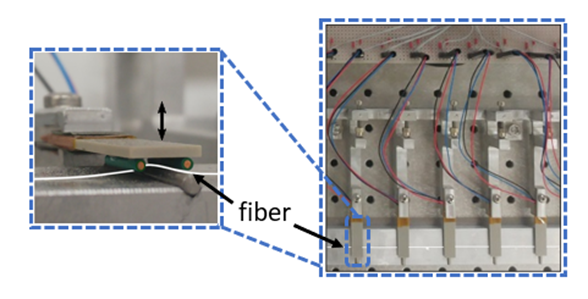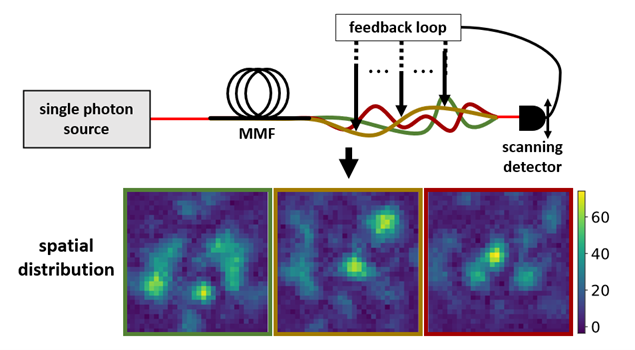All-fiber Control of Entanglement:
Recovering Correlations via Mechanical Perturbations in a Multimode Fiber
In quantum optical communications, single photons can be used as a unit of quantum information. However, one can supercharge their capacity to carry information by encoding high-dimensional quantum dits, or qdits, into their transverse shape. They allow having more than two levels per unit of information as it is the case for bits. In fiber optical communications, it requires using multimode fibers to harness the spatial degrees of freedom to encode the qduts. However, when propagating through a real-life multimode fiber, the transverse shape of the photons gets scrambled because of mode mixing and modal interference. This scrambling of transverse shape is typically rectified using free-space spatial light modulators. But, this remedy prevents us from achieving a truly resilient all-fiber operation and requires a careful alignment and lab-graded stability hindering real-life implementation. In [R. Shekel et al., Arxiv 2306.02288 (2023)], the authors introduce an all-fiber method for controlling the shape of single photons and spatial correlations between entangled photon pairs. They do so by implementing carefully controlled mechanical perturbations to the fiber.
Written using text and figures by R. Shekel (@RonenShekel) and O. Lib (@OhadLib) from this Thread.
Introduction
Single photons serve as the fundamental unit of quantum information. However, we can supercharge their capacity to carry information by encoding high-dimensional quantum dits, or qdits, into their transverse shape. To give you an understanding, a qdit is like a more capable version of a qubit, the basic unit in quantum computing. Unlike a qubit which has only two states, a qdit possesses more than two states, offering a larger space for information representation.
Long-haul communications are predominantly handled by single-mode fibers. However, these fibers don't provide the spatial diversity required for implementing qdits. On the other hand, multimode fibers, living up to their name, offer multiple spatial modes. These can be utilized to encode qdits using those transverse modes, as depicted in Fig 1.
Figure 1: Qdits. Example of a way to encode qudits using photons in different modes (i.e. different spatial profiles) of a multimode fiber.
However, a challenge arises when photons travel through a multimode fiber, as their transverse shape becomes scrambled due to mode mixing and modal interference. Traditionally, this complication is addressed using free-space spatial light modulators. Yet, this corrective measure hampers a truly robust all-fiber operation.
Principle
A significant factor contributing to mode mixing, which results in scrambling the photons, comes from external perturbations to the fiber. This particularly involves changes to the fiber's spatial shape, such as bending, twisting, and stress among other factors. Herein lies the author's innovative thought, a concept previously employed for classical optics in [S. Resisi et al. APL Photon. (2020)]. The authors harness this very source of unwanted disturbance to manage light propagation inside the fiber. In doing so, they can shape the photons and counteract these unwanted perturbations. To achieve this goal, they employ a set of 37 piezoelectric actuators located along a graded index MMF to control light propagation. The principle of the setup is illustrated in Fig 2.
Figure 2. Mechanical control of fiber perturbations using piezoelectric actuators.
By adjusting the voltage applied to the actuators, we can manipulate the shape of the fiber, which consequently alters the spatial distribution of the output intensity. Employing a feedback loop allows us to fine-tune this output intensity according to our desired objective, as demonstrated in [S. Resisi et al. APL Photon. (2020)] and is illustrated in Fig. 3.
Figure 3. Control of the output intensity pattern by mechanical control of the fiber shape.
In this study, the authors use this method to control the shape of single photons as well as the spatial correlations between entangled photon pairs. This is achieved by meticulously choosing the mechanical perturbations applied to the fiber.
Optimization of the coincidence counts of single heralded photon
In this configuration, which is relevant to high-d quantum communication, Alice sends a heralded single photon to Bob via a multimode fiber (MMF). Prior to optimization, the photon reaching Bob is delocalized, as evidenced by the speckle pattern in the coincidence map. Following the optimization process, we manage to localize the photon arriving at Bob's end, achieving an enhancement of more than an order of magnitude. Results are shown in Fig. 4.
Figure 4. Optimization of single heralded photons.
Optimization of the coincidence counts of photon pairs
In another configuration, both photons are dispatched through the MMF, effectively harnessing MMFs for quantum circuits on a biphoton state. Similar to the previous setup, the coincidence map is optimized from an apparently random speckle pattern to a well-focused spot, achieving an enhancement of more than a factor of 10 (see Fig. 5).

Optimizing coupling to a single-mode fiber
Another practical hurdle for multimode quantum optical applications lies in the collection of light. A typical setup might involve a multimode fiber, embodying the communication line, linked to a single-mode fiber, utilized for the collection and measurement of photons. However, in the absence of specialized manipulation, the collection efficiency is typically low, given that the shape of the photons exiting the multimode fiber doesn't align with the spatial mode of the single-mode one. Using the same setup, the authors show the potential to boost this collection efficiency, achieving an enhancement of over a factor of 10 yet again.
Conclusion
Multimode fibers, on paper, present a promising prospect for enhancing both classical and quantum optical communication systems. However, in practice, several technical challenges are faced. This paper illustrates the feasibility of rectifying most of these hurdles without resorting to free-space optics. This offers a potential pathway to stable, compact systems that are practically applicable in real-world scenarios.



